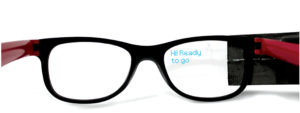Meet the teenage prodigy whose most recent invention is a device that will enable hearing impaired individuals to communicate with others without sign language
A 17-year-old boy with a nearly non-existent social media presence. Find that hard to believe? Well, Madhav Lavakare, a teenaged inventor with a keen interest in music, will smash all the stereotypes we harbour about millennials.
Lavakare has been in the process of developing a heads-up technology in the form of a wearable assistive smart glass device to help the hearing impaired with day-to-day conversation. A product akin to the Google Glass, his device — Transcribe — is equipped with a software that converts audio to text on a screen attached to the lenses of the glasses, making it easier for hearing impaired individuals to communicate with others without sign language. “People with hearing loss are only able to effectively communicate via sign language with people from within that community. The likelihood of people without a hearing impairment to know sign language is quite slim. So, with this product, I wanted to attempt to bridge that communication gap.”
He goes on to explain that there have been other devices and apps with similar objectives, but they have either been very expensive, or an interface that would require people to read from their phone apps. “Actually, 93 per cent of our communication is non-verbal. Which means only seven per cent of our conversations actually lie in the words we exchange. The rest is in our body language. The point of this product is to be able to translate that experience holistically, so that the hearing impaired can observe the body language and the environment and then participate in conversations unhindered.”
Madhav considers himself to be an autodidact, and has described himself as a “tinkerer, maker and problem solver”. Most of his skills and personal projects were born out of interests he developed and consequently taught himself, be it coding or music. At a very young age, he invented a voice automation system that would switch the lights and fans in his home on and off on command, and also installed a self-made burglar alarm in his room to keep his parents out. For the last ten years he has been dabbling in music, he’s learnt the piano and guitar by himself with only a little bit of formal instruction, and is also producing electronic music for his YouTube channel.
Despite this, he insists on the importance of schooling, “I know it would have been easier to focus on these projects, if I had dropped out, but I don’t want to do that. I can’t be missing and failing classes.” While juggling school alongside all the work he needs to put in for Transcribe does prove difficult, Madhav believes that the social skills and basic teachings one gets in a school environment cannot be made up for. “It’s the passion for this company that has driven me to work hard,” he says, all the while maintaining that he would not trade what he learns in school for anything.

“I’ve always been the type of kid who loves solving problems, building machines and tinkering with gadgets,” he tells Patriot. He was very intrigued by the Google Glass product, and wanted to create a more affordable version of the same. The original Google Glass device was priced at $1500, whereas his first prototype would cost about Rs 2500, which is approximately $36. A friend of Madhav’s who was hearing impaired had to drop out of school as he could not cope due to his disability. All of these factors prompted him to work on Transcribe as a realistic project with the objective to help the differently abled at a reasonable price. “There is barrier of communication between those that are hearing impaired, and those that are hearing enabled but cannot speak sign language,” explains Madhav, “that was the birth of Transcribe.”
Madhav spoke to all the stakeholders himself. He approached experts, doctors and audiologists, and also conducted a pilot test with about 45 users.
“The users’ feedback was really important to me,” he adds. While admittedly a few problems did surface in the making of the prototype, such as the speed of the speaker, or how fast the user is reading the text on the screen, Madhav is currently working on fixing those factors for his next prototype.
Alongside his team, he is exploring a few options, that would entail customising the speed of the of the audio-text conversion to the comfort of the user.
“We’ll keep a buffer where the speed can be adjusted to the convenience of the reader,” he says.
This project has been in the works for months, says Madhav, with the sourcing of the parts being a challenging affair. “It has taken about five to six months to create a new prototype each time,” he says, “I had the idea about two years ago, and it took me about five months to create the first working prototype.” He first tested it with friends and family with regard to the design and the functionality. With that he returned to the basics to make the new iteration of the product, which took him another five months, before he decided to test it out with other users. He tied up with many NGOs working with the deaf — like the National Association of the Deaf — to interact with the users and monitor how they use the device. “Rather than product development, I think I was more focused on user development,” he adds. He was also recently invited to the NASSCOM Product Conclave in Bengaluru and was the youngest speaker there.
He has been an inventor from the young age of six and has been creating devices from bits and scraps for many years now. So why has he not chosen to monetise any of his inventions until now? “The earlier things I did were not hobbies, but more like projects. They were either solving my own problems or my family’s problems. They weren’t really addressing any real concerns,” he explains, adding, “None of these were things that I saw as having a huge impact on the society.” “Transcribe however, has an implication for about 70 million people in India, which is why I decided to monetise this particular product so as to make it a sustainable venture with future prospects and make it better and better.”
Are there any projects that Madhav has in mind that he may be taking up in the foreseeable future? “I always have plans, but to make the time and get the resources for them is the problem,” he replies with a laugh. He aims at developing another tool which would be a part of a kit, alongside his smart glasses, that would translate sign language to audio or text. He speaks of a pair of gloves enabled with sensors which would read the actions made by the user, “this way the user can just sign whatever they want to say, and the product will automatically convert that to spoken or written word.” He hopes to make both these products into a low-cost communication kit for the hearing impaired.
Besides the ingenuity and surprising modesty with which Madhav Lavakare conducts himself, what is also striking is his lack of social media presence.
“I’m not on social media,” he says. He doesn’t even use Facebook or WhatsApp. “About two years ago, I made the conscious decision to back off from social media because I realised that it was not adding any value to my life. I already had a lot going on in life, and I could talk to my friends even without social media.”
Madhav has spent significant amounts of time trying to perfect Transcribe as a product and is still attempting to make it even better and more user-friendly than it already is. In closing, he says, “It’s going to take a while for this product to reach perfection and launch it in the market — maybe five or six more generations. And it’s a long journey, but it’s a journey I want to make. The aim is not to make profit, but to make enough revenue so that I am able to put it into research and development, and make this product even better.”





